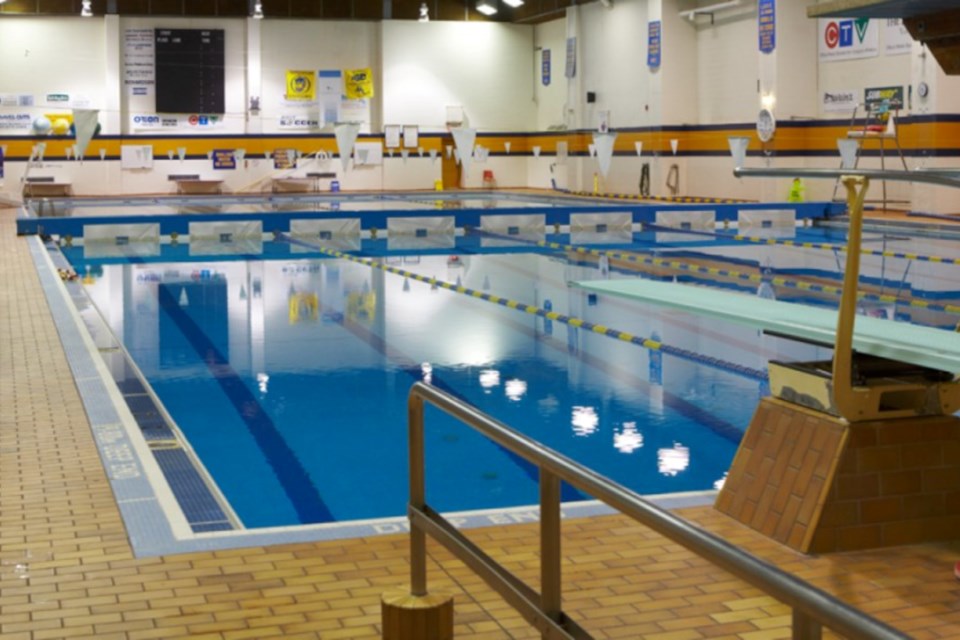Laurentian University has provided the community with an update on the status of its swimming pool, which has been closed for nearly three years now, as the university weathered the COVID-19 pandemic and its own insolvency.
The university’s interim president, Sheila Embleton, said in the Jan. 31 written update that since beginning her role at the beginning of January, many people have brought up the importance of the Jeno Tihanyi Olympic Gold Pool, including LU board members.
“There is a strong desire to re-open the pool,” she said, in the update.
The pool, which was built in 1972, was shut down in the spring of 2020 as a result of the COVID-19 pandemic, and never reopened.
At a May 2022 meeting of Laurentian’s senate, LU vice-president, finance and administration Michel Piché said the pool, which had been kept filled and heated during the shutdown, began to leak early last year, and by March 2022, the pool “was essentially empty.”
Piché said that while Laurentian continued to undergo insolvency restructuring under the Companies’ Creditors Arrangement Act (CCAA), there was “limited funding available for these kinds of repairs.”
Laurentian said in 2020 that a report from KPMG had found that the Ben Avery Complex and the Jeno Tihanyi pool required more than $10 million in maintenance.
Piché said an engineering firm hired in late 2021 to do a structural review of the pool walls indicated that repair work totalling $140,000 would need to be done to fix those issues.
Embleton, the school’s interim president, said in this week’s update that with LU finally exiting the CCAA in November, “we are now able to further investigate the nature of repairs required to return the pool to an operational state.
“A significant investment is required to perform a series of tests on the pool to assess the extent of the work to be done,” Embleton continued.
She said the testing process, funded by the university, will begin in February, and does not yet have an estimated completion date. An update will be provided to the community when the testing has progressed significantly, no later than April 30.
“This is an important step towards understanding the required financial investment involved,” Embleton said.
She said in her update that it remains unlikely, however, that the university will be able on its own to bear the costs associated with the operations of the pool and will need to seek external investment.
“Once the assessment has been completed, we will continue discussions with third parties to explore funding options for the pool,” Embleton said.
Following the announcement, Sudbury.com reached out to Dean Henze, head coach with the Sudbury Laurentian Swim Club, a youth competitive swim program that had been one of the main user groups at the pool.
Henze had pointed out in a tweet last week that the pool was once again mostly filled with water.
This is a sight I’ve been patiently waiting for. Perhaps the beginning of the end of an exile. pic.twitter.com/MwuDSYfWWw
— Dean Henze (@SLSCcoach) January 27, 2023
Henze said until the testing is completed, it’s hard to say when his club will be able to use the Laurentian pool again.
He said some grants may be available to Laurentian to complete pool repairs, and the swim club would also be willing to apply for grants to help out.
“My best-case scenario is that by the end of spring, we're in there,” he said. “But that would be all systems running perfect. And, you know, aside from that, I sure would be hopeful that by September, we're in there. But again, it depends on what they find.
“We are at the mercy of time, with what damage was done in the previous three years of just sitting there idle, particularly the last 12 months of it being empty, and also coming to some sort of financial solution to the operational costs of the pool, going forward.”
Sitting empty is “never good for a pool,” Henze said. “The seals in the pumps and the valves and everything dry out. That’s not good. The filters need to be checked out, and the filters are original to the 50-year-old build. If you read the announcement, I think that's clearly what they're doing now.”
Prior to the COVID shutdown in 2020, “the pool was operating normally,” he said. “Everything was fine. They had invested a fair bit of money into the air exchange systems and things like that. So there was nothing majorly wrong with the pool.”
As for the reasons behind the prolonged shutdown, Henze said he thinks “somebody involved with the CCAA process made it pretty clear that no money was heading to that pool until they were done.”
In terms of operational costs, Laurentian has begun consulting with user groups “to see if they can make the numbers work,” Henze said.
“I would imagine that they have to get creative on how they make some revenue to help reduce the cost,” he said. “I would hope they’re realistic and don’t put the entire utility costs of the Ben Avery building onto the pool.”
Due to Laurentian keeping its pool closed following the lifting of COVID restrictions, the swim club has been forced to rent pool time from the City of Greater Sudbury.
Henze said the same is true for the synchro and master’s swimming programs that operated out of the Jeno Tehanyi pool, and, initially, Laurentian’s varsity swimming program as well.
Laurentian cut its varsity swim and hockey teams in 2021 as part of the CCAA, although Henze hopes the swim program will be reinstated.
“We are just looking forward to getting back home,” Henze said.
Heidi Ulrichsen is Sudbury.com’s associate content editor. She also covers education and the arts scene.
